I was thinking about how widespread these axes were and it seems to me they were well accepted in a relatively broad are, but I don't know how broad exactly and how early. For example, Anglo Saxons started to use it after Danish conquest of England. Would Normans use them because of their Danish connections? Would dane axes be present on the both sides at the battle of Hastings? Of course they wouldn't be very practical for Norman knights, but Norman infantry could use them...
The Anglo-Normans used them in the 12th century - King Stephen wielded one at Lincoln in 1141 in preference to a sword until it broke, according to Henry of Huntingdon. I don't think that the Normans used them prior to Hastings, as they seem to be identified as a Saxon distinctive in the Bayeux Tapestry. William of Malmsebury mentions the Anglo-Saxons as being all armed with axes - he is writing several generations later and exaggerates, but it does show that the broadaxes of the Anglo-Saxons made a big impression on those who actually fought the battle and suggests that the Normans were not very familiar with them prior to 1066.
I don't seem to be able to find translations of other contemporary sources, but it would be interesting to see if they specifically mention the broadaxe and how.
I don't seem to be able to find translations of other contemporary sources, but it would be interesting to see if they specifically mention the broadaxe and how.
It depends on how do you exactly define "dane axe" I guess, but it seems that generally all kinds of large, two handed axes were definitely popular in "Dark Ages", especially on the break of millennia.
Remains of some 123 axes were found in the Lednica lake - and a lot of them was most probably of the two handed variety, judging on the head size.
http://znaleziska.org/wiki/index.php/Topór_(Lednica)
Doesn't really have "Dane" profile though, so it depends on what you're looking for.
Remains of some 123 axes were found in the Lednica lake - and a lot of them was most probably of the two handed variety, judging on the head size.
http://znaleziska.org/wiki/index.php/Topór_(Lednica)
Doesn't really have "Dane" profile though, so it depends on what you're looking for.
yes they were spread to the east quite wide,
the scandinavian-origin rus-people in nowadays south-western russia used them..
and they were used in constantinople and the balkans by byzantine varangians (mostly of norse origin until the 12th-13th century, when many englishman came, but the dane axe still remained kind of status symbol with the varangians til the fall of byzanz in 1453.
the scandinavian-origin rus-people in nowadays south-western russia used them..
and they were used in constantinople and the balkans by byzantine varangians (mostly of norse origin until the 12th-13th century, when many englishman came, but the dane axe still remained kind of status symbol with the varangians til the fall of byzanz in 1453.
One of the problems with this question is exactly what you define as a "daneaxe".
If you refer to the scandinavian style broadaxes of Pettersen's type L and M, these are as far as I know mostly used in the scandinavian region, with native styles such as the ones Bartek posted being used in the western european and slav terretories.
The broadaxe shape remains in use for quite a while in scandinavia, though. Where high medevial illustrations from other areas usually show crecent shaped axes, the scandinavian ones still have the Pettersen L or M profiles untill the 1300 hundreds...
If you refer to the scandinavian style broadaxes of Pettersen's type L and M, these are as far as I know mostly used in the scandinavian region, with native styles such as the ones Bartek posted being used in the western european and slav terretories.
The broadaxe shape remains in use for quite a while in scandinavia, though. Where high medevial illustrations from other areas usually show crecent shaped axes, the scandinavian ones still have the Pettersen L or M profiles untill the 1300 hundreds...
Yes, the axes I am interested in are Petersen L and M, M especially since I will have one soon and I wondered with how many different kits it could go. :) Your answers are what I pretty much expected, I just hoped Normans might have used it before Hastings, but no big problem for me since I have the sword for a Norman kit. ;)
What about Ireland and Scotland? A lot of Scandinavian influence there, any evidence for dane axes? What did the Galowglass warriors used before their typical sparth axes developed?
What about Ireland and Scotland? A lot of Scandinavian influence there, any evidence for dane axes? What did the Galowglass warriors used before their typical sparth axes developed?
whethr one calls this increased area is debtable because the varangian guardsmen werewell kniw for their tall, and broad bladed axes and wahs used by the varangians and their more native descendents.
dane axes are a pricey and a specialty weapon so there never as commen or wide spread as cheaper and more versatile weapons.
Illustrations of Irish warriors in the 12th-13th centuries commonly show Irish warriors armed with a 2 handed danish type ax. Suprisingly to me at least, armour is not commonly illustrated in these pictures as being worn by the ax users.
It seems the "Danish Ax" was spread to Ireland as well.
If you mean spears by cheaper weapons (though versatile is in question) I'd probably agree to a point. Possibly another "cheaper" weapon would be a shorter seax type weapon as well.
However, making a danish axe would not be as expensive as a sword or other weapons, I think an ax would be cheaper for the commoner.
It seems the "Danish Ax" was spread to Ireland as well.
| Quote: |
| dane axes are a pricey and a specialty weapon so there never as commen or wide spread as cheaper and more versatile weapons. |
If you mean spears by cheaper weapons (though versatile is in question) I'd probably agree to a point. Possibly another "cheaper" weapon would be a shorter seax type weapon as well.
However, making a danish axe would not be as expensive as a sword or other weapons, I think an ax would be cheaper for the commoner.
| Gary Teuscher wrote: | ||
| Illustrations of Irish warriors in the 12th-13th centuries commonly show Irish warriors armed with a 2 handed danish type ax. Suprisingly to me at least, armour is not commonly illustrated in these pictures as being worn by the ax users.
It seems the "Danish Ax" was spread to Ireland as well.
If you mean spears by cheaper weapons (though versatile is in question) I'd probably agree to a point. Possibly another "cheaper" weapon would be a shorter seax type weapon as well. However, making a danish axe would not be as expensive as a sword or other weapons, I think an ax would be cheaper for the commoner. |
Well, Dane axe (or broadaxe as it is often called here) is a specialized military hardware - it is designed as a weapon, and not really all that well suited for tasks a commoner would have for everyday axe. Also, it takes considerable skill to use those weapons efficiently, so I do not really believe they where ever all that common among commoners. Here we often found them in burials that also have items that indicate that owner held a significant position in society and was by no means a simple peasant.
| Quote: |
| is a specialized military hardware - it is designed as a weapon, and not really all that well suited for tasks a commoner would have for everyday axe |
Well, if looking at that as a definiton, Most weapons of war are designed specifically for war. I guess you were comparing them with makeshift weapons.
| Quote: |
| Here we often found them in burials that also have items that indicate that owner held a significant position in society and was by no means a simple peasant. |
well, simple peasant usually did not fight in armies. Meaning that most men, even those that were conscripted due to feudal obligations, were a bit more than a simple peasant. Looking at the various assize of arms (and assuming that apllied to some exttent to the rest of Europe) those fighting came not from the bottom of society, but from the middle up.
| Gary Teuscher wrote: | ||
Well, if looking at that as a definiton, Most weapons of war are designed specifically for war. I guess you were comparing them with makeshift weapons. |
I am comparing them to the axes that are usable both as tools and as weapons - for example, we find a lot of axes in burials during late iron age, but majority of them are usable well enough both as tools and as weapons, if needed. "Dane axe" is not well suited for things like chopping wood or building houses and such - it is very effective weapon though. That is what I meant as "specialized military hardware" in this case.
| Quote: |
| Here we often found them in burials that also have items that indicate that owner held a significant position in society and was by no means a simple peasant. |
well, simple peasant usually did not fight in armies. Meaning that most men, even those that were conscripted due to feudal obligations, were a bit more than a simple peasant. Looking at the various assize of arms (and assuming that applied to some extent to the rest of Europe) those fighting came not from the bottom of society, but from the middle up.[/quote]
Again, we find significant amount of weapons in the burials of people we consider to be "free man" - spearheads, axes, battleknives... but the more "higher-up" person seems to have been - judging from the amount and variety of burial goods it was provided with, the more specialized and easily distinguishable his "military items" become - we see swords, we see specific types of spears and axes - ill suited for things other than killing other people. "Dane axe" is one of such items.
Yeah, if you're looking for a late date as well, it would probably be Ireland. It was in use at least as late as 1581, the date of the images below.It's most often associated with the Gallowglass warrior class, but if these images are to be believed (they're propaganda, after all,) long axes also were used by others of relatively high status. The image below of the horseman and two attendants pretty neatly describes the kinds and quality of kit men of each class would be expected to have. The middle rank is shown in several places with long axes of this stylized form. The routed men in the middle image below may be Gallowglass, judging from what appear to be helmets and hauberks.
 Attachment: 231.54 KB
Attachment: 231.54 KB
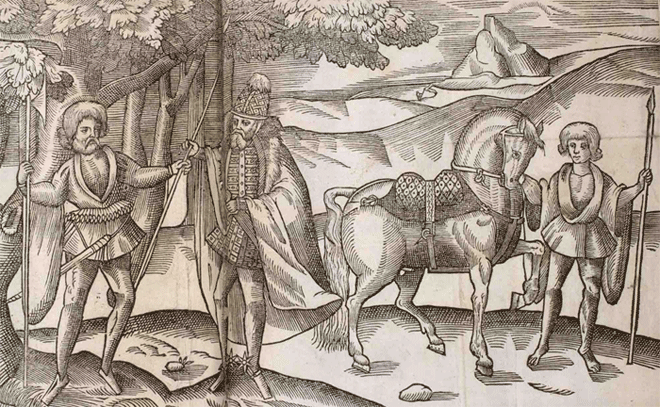
 Attachment: 164.65 KB
Attachment: 164.65 KB
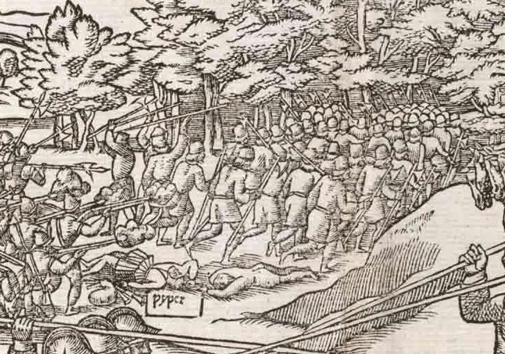
 Attachment: 191.11 KB
Attachment: 191.11 KB
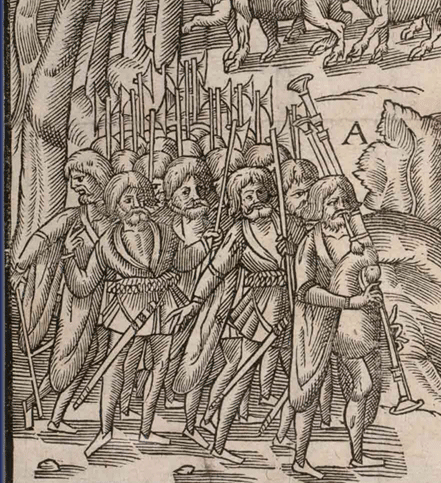



| Quote: |
| "Dane axe" is not well suited for things like chopping wood or building houses and such - it is very effective weapon though. |
Absolutely correct - it's too light to be a good wood chopper, but that makes it an effective weapon as well.
But then Spears and swords as well as maces and many types of pole arms would fall in the "specialized" weaponry.
And to an extent bows as well - You don't need a 150 pound draw for hunting. And arrowheads are usually made for one or the other, the Viking age and Norman arrows that were similar to a bodkin were not for hunting, nor the later bodkin types.
| Quote: |
| Again, we find significant amount of weapons in the burials of people we consider to be "free man" - spearheads, axes, battleknives... |
Again, I'd say spears are far more for war than the hunt. With the axes - it's hard to say they were indeed used for war, they may well just have been tools.
The Battle knifes I'll agree on - the Seax, while a nice weapon for war was also rather mutlipurpose.
Though the longer versions of the Seax I'd say were pretty well weapons of war.
The Irish Kerns used long battle axes as well did they not?
I guess my point on the matter is those who were the bottom dregs of society - from both wealth and status - really did not fight in wars to begin with.
Soldiers were not generally recruited from the Cottars of the Serf Class, nor the Nordic Thralls.
There are many mentions of musters where the less well equipped are sent home - perhaps fined as well if armed/armoured with less than what there station requires.
I guess my point on the matter is those who were the bottom dregs of society - from both wealth and status - really did not fight in wars to begin with.
Soldiers were not generally recruited from the Cottars of the Serf Class, nor the Nordic Thralls.
There are many mentions of musters where the less well equipped are sent home - perhaps fined as well if armed/armoured with less than what there station requires.
| Gary Teuscher wrote: |
| The Irish Kerns used long battle axes as well did they not?
I guess my point on the matter is those who were the bottom dregs of society - from both wealth and status - really did not fight in wars to begin with. |
The lowest classes in the Derrick images are shown bare-legged, barefooted, with simple tunics and spears. We know they also used darts. What I'm calling the middle class of Kern have the finer clothes, shoes, the distinctive Irish long knife and axe. I guess the Kern were not uniformly poor.
One explanation for more widespread use in Ireland is that metal production had likely reduced the cost of such weapons by the 16th c. Another is that the axe was a common weapon in Irish culture, or so I've read. More folks familiar with the weapon + reduced cost = more use.
The myArmoury article of the Irish armies is helpful here:
It seems the terms Bonnacht and Kern are used here a bit interchangibly?
| Quote: |
| The ordinary Irish foot soldiers, made up partly of "bonnachts", or Irish mercenaries maintained by the various nobles, and partly of free peasantry called out to fight. The bonnachts might sometimes be dressed like the gallowglasses, or else like the rising-out, as the peasants were called; that is, no armour, simply the traditional Irish dress of a linen tunic with very wide sleeves, often dyed yellow with saffron, usually worn over tight trews of a plain color, and sometimes covered with a very short coat of goat's hair or a large mantle or "shag-rug", patterned, and with a long fringe of "an agreeable mixture of colors".
This print from John Derrick's "The Image of Ireland" (1581) shows Ulster Kern indulging in their usual raiding. The particular type of jacket worn, with pleated "frill", is probably an Ulster variation. At lower left the men with long axes are probably bonnachts. Note the bagpiper. (British Library) Bonnachts might have been armed with the sparth-axe, but the usual weapons were javelins or "darts" of which each kern had a handful; even the English admitted that the Irish were extraordinarily skilled with this weapon, but said it was "More Noisesome, especially to the Horse, than deadly". |
It seems the terms Bonnacht and Kern are used here a bit interchangibly?
This is Wikepedia, but references sources and seems to be pretty accurate, points out that worse equipped soldiers were sent home, and that you generally were at least a bit of a man of substance if serving in the "army".
12. ^ cf. Statutes of the Parliament of December 1318 (1318/29)
13. ^ "Each was furnished with light armour, not easily penetrable by a sword. They had axes at their sides and carried lances in their hands".Vita Edwardii II
The only thing I am curious about is if the whole of the infantry was equipped with a gambeson. There was a focus by the crown at this time in england to not have "naked" troops, i.e. at least a gambeson, though in practice there were many without even a gambeson showing up at musters.
A bit off topic, but I find that they got somehting else right as well - that the Scottish archers were also "lonbow" equipped - just not in great numbers.
| Quote: |
| The army might have numbered as many as 9,000 men in all, but probably more of the order of 6,000–7,000. It was gathered from the whole of Scotland: knights and nobles, freemen and tenants, town dwellers and traders: men who could afford the arms and armour required. Barbour tells that King Robert turned away those who were not adequately equipped. For most, such equipment would consist of a spear, a helmet, a thick padded jacket down to the knees and armoured gloves.[12][13] It is highly probable that a large proportion of the spearmen had acquired more extensive armour given that the country had been at war for nearly twenty years. This is in contrast to the modern romantic notion of the Scots army, which depicts its foot soldiers clad in kilts, painted woad and little else. The balance of the army consisted of archers and men-at-arms. The Scottish archers used yew-stave longbows and it is not to be thought that they had weaker or inferior bows but rather had inferior numbers.[14] Consisting of possibly only 500 archers, they played little part in the battle.[15] There is first hand evidence from the captured Carmelite friar, Robert Baston in his poem, written just after the battle, that one or both sides employed slingers and crossbowmen.[16] Each of these troop types was indistinguishable from their counterparts in France or England. Many of the Scottish men-at-arms (recruited from the nobility and the more prosperous burgesses) served on foot at Bannockburn. |
12. ^ cf. Statutes of the Parliament of December 1318 (1318/29)
13. ^ "Each was furnished with light armour, not easily penetrable by a sword. They had axes at their sides and carried lances in their hands".Vita Edwardii II
The only thing I am curious about is if the whole of the infantry was equipped with a gambeson. There was a focus by the crown at this time in england to not have "naked" troops, i.e. at least a gambeson, though in practice there were many without even a gambeson showing up at musters.
A bit off topic, but I find that they got somehting else right as well - that the Scottish archers were also "lonbow" equipped - just not in great numbers.
| Sean Flynt wrote: |
| Yeah, if you're looking for a late date as well, it would probably be Ireland. It was in use at least as late as 1581, the date of the images below.It's most often associated with the Gallowglass warrior class, but if these images are to be believed (they're propaganda, after all,) long axes also were used by others of relatively high status. The image below of the horseman and two attendants pretty neatly describes the kinds and quality of kit men of each class would be expected to have. The middle rank is shown in several places with long axes of this stylized form. The routed men in the middle image below may be Gallowglass, judging from what appear to be helmets and hauberks. |
Some of these look a bit off for the dane axe, but the artist might have meant to paint the dane axe and slightly missed the shape of one. Basically, dane axe in 12th or 13th century ireland is enough for me, I'm not that interested in later centuries...
I was looking at the pictures of Bayeux tapestry and saw this picture of Normans transporting arms and armor, and there is an axe looking pretty much like Petersen type M. Maybe there were some dane axes on Norman side too if we believe the author of the tapestry. ;-)
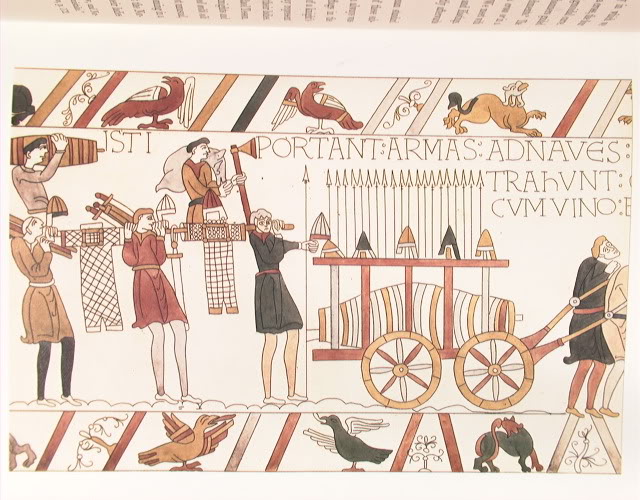
And btw, who is this guy with a dane axe in the picture below? Harold or William? I understood it's William but I'm not sure...
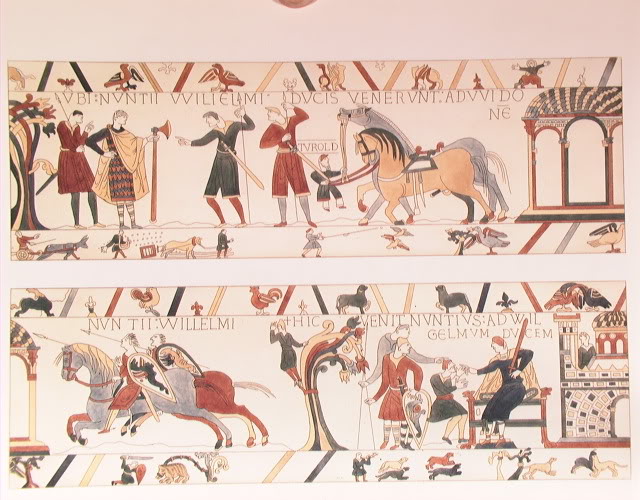

And btw, who is this guy with a dane axe in the picture below? Harold or William? I understood it's William but I'm not sure...

Last edited by Luka Borscak on Mon 07 Nov, 2011 10:18 am; edited 1 time in total
Page 1 of 2
You cannot post new topics in this forumYou cannot reply to topics in this forum
You cannot edit your posts in this forum
You cannot delete your posts in this forum
You cannot vote in polls in this forum
You cannot attach files in this forum
You can download files in this forum
All contents © Copyright 2003-2006 myArmoury.com — All rights reserved
Discussion forums powered by phpBB © The phpBB Group
Switch to the Full-featured Version of the forum
Discussion forums powered by phpBB © The phpBB Group
Switch to the Full-featured Version of the forum